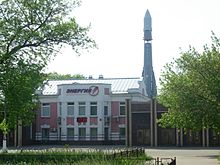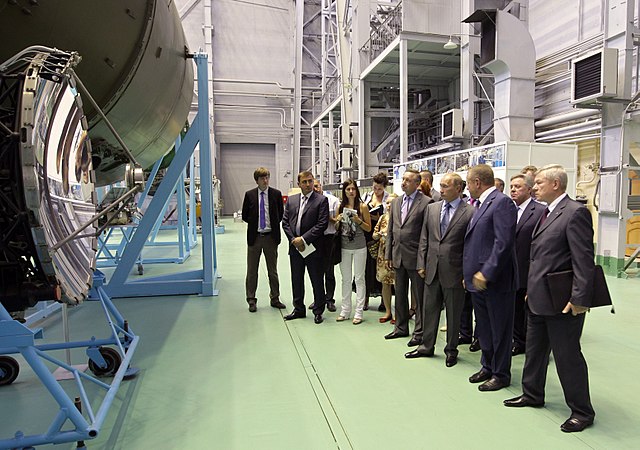Loading AI tools
Russian spacecraft manufacturer From Wikipedia, the free encyclopedia
S.P. Korolev Rocket and Space Corporation "Energia" (Russian: Ракетно-космическая корпорация «Энергия» им. С. П. Королёва) is a Russian manufacturer of spacecraft and space station components. Its name is derived from the Russian word for energy and is also named for Sergei Pavlovich Korolev, the first chief of its design bureau and the driving force behind early Soviet accomplishments in space exploration.
 | |
 Company headquarters in Korolyov | |
Native name | Ракетно-космическая корпорация «Энергия» им. С. П. Королёва |
|---|---|
| Formerly | RSC Energia RKK "Energiya" NPO Energia TsKBEM OKB-1 |
| Company type | Public |
| Industry | Aerospace, defense |
| Founded | 26 August 1946[1] |
| Founders | Sergei Korolev |
| Headquarters | , Russia |
| Revenue | US$726 million (2017)[2] |
| US$37.8 million (2017)[2] | |
| US$21.1 million (2017)[2] | |
| Total assets | US$1.97 billion (2017)[2] |
| Total equity | US$65.3 million (2017)[2] |
| Owner | United Rocket and Space Corporation (38.2%)[3] |
Number of employees | 7,791 (2017) |
| Website | energia.ru/english |
Energia is the largest company of the Russian space industry and one of its key players. It is responsible for all operations involving human spaceflight and is the lead developer of the Soyuz and Progress spacecraft, and the lead developer of the Russian end of the International Space Station (ISS). In the mid-2000s, the company employed 22,000–30,000 people.[4]
The enterprise has been awarded 4 Orders of Lenin, Order of the October Revolution and Russian Federation President's Message of Thanks. In addition, 14 cosmonauts employed by the company have been awarded the title "Hero of the Russian Federation".[5]

The company consists of the following subsidiaries and branches:[5]
As of 2009[update], 38% of the company's stock was owned by the Russian state.[5]
The company was founded on 26 August 1946[1][lower-alpha 1] and has been known successively as:
It is named after the first chief of its design bureau Sergei Korolev (1946–1966). His successors as chief designers were: Vasily Mishin (1966–1974), Valentin Glushko (1974–1989), Yuriy Semenov (1989–2005), Nikolai Sevastianov (2005–2007). Its President and Chief designer was Vitaly Lopota, until 1 August 2014.[7]
Korolev's design bureau was, beginning with the first artificial satellite Sputnik 1 and the first crewed spaceflight of Vostok 1, responsible for a major part of the Soviet space program. It was the main rival of OKB-52 (later known as TsKBM, then the design bureau of Vladimir Chelomei) during the Soviet crewed lunar programs and the Soviet space station program.[8] OKB-1 was among others responsible for the development of the crewed Soyuz spacecraft and its Soyuz rocket, the N1 "Moon Shot" rocket, large parts of the Salyut space station program, the uncrewed Progress resupply craft and designed the Energia rocket for the Buran space shuttle program. Since the early beginnings of the Luna programme it designed many space probes, among others of the Venera, Zond and Mars program.
The company continues to dominate a large part of the Russian space program, and a considerable part of the World's space program, with its Soyuz spacecraft having become the only crewed spacecraft conducting regular flights and the exclusive crew transport vehicle for the International Space Station from the Space Shuttle retirement in 2011 and until the maiden flight of Crew Dragon Endeavour in 2020. The Chinese Shenzhou program is the only other program in the world with planned semi-regular crewed spaceflights.
The President of Energia, Vitaly Lopota, was removed from his post as president on August 1, 2014. Dmitry Rogozin indicated that this was the start of "long-awaited personnel reform in [the Russian] space industry... Tough times require tough decisions".[7] Lopota was offered the position of vice president for technological development in the United Rocket and Space Corporation,[7] the new company formed in 2013 to re-nationalize the Russian space industry.[9]
Energia builds:
Over the years the products of Energia and its predecessors included:
Including meteorological rockets as their modifications:

Committee of Innovative Youth Projects (Russian: Комитет инновационных проектов молодежи) also known as KIPM of RSC Energia is a network structure that unites specialists and heads of different divisions to quickly develop and launch innovative products. KIPM was established in early 2016 on the initiative of a group of young engineers from the RSC Energia. The main task of the new structure is to give young specialists the opportunity to realize their creative ideas. The main criterion for projects selecting is their potential demand in the market.
Currently KIPM work on five projects:
Seamless Wikipedia browsing. On steroids.
Every time you click a link to Wikipedia, Wiktionary or Wikiquote in your browser's search results, it will show the modern Wikiwand interface.
Wikiwand extension is a five stars, simple, with minimum permission required to keep your browsing private, safe and transparent.